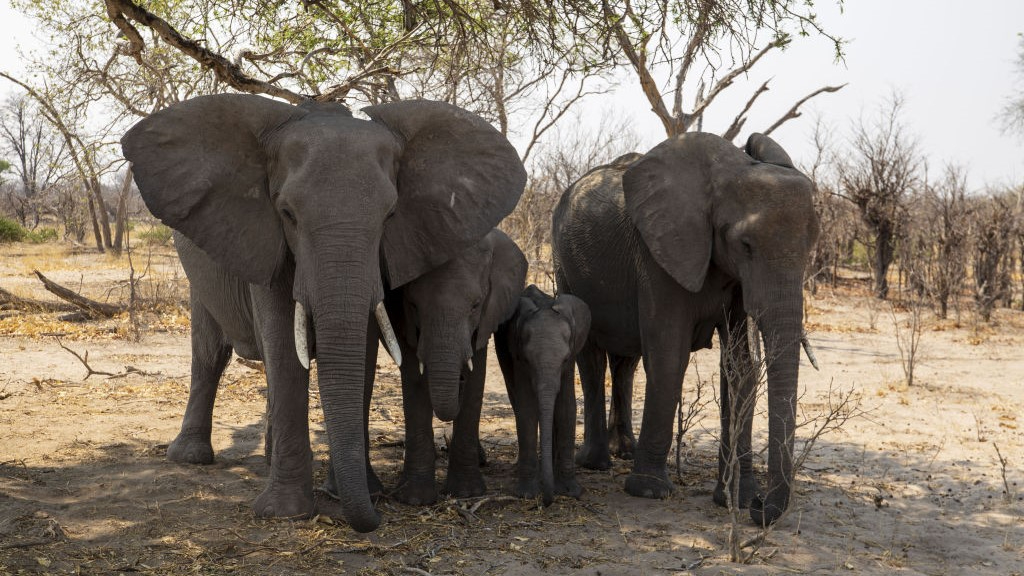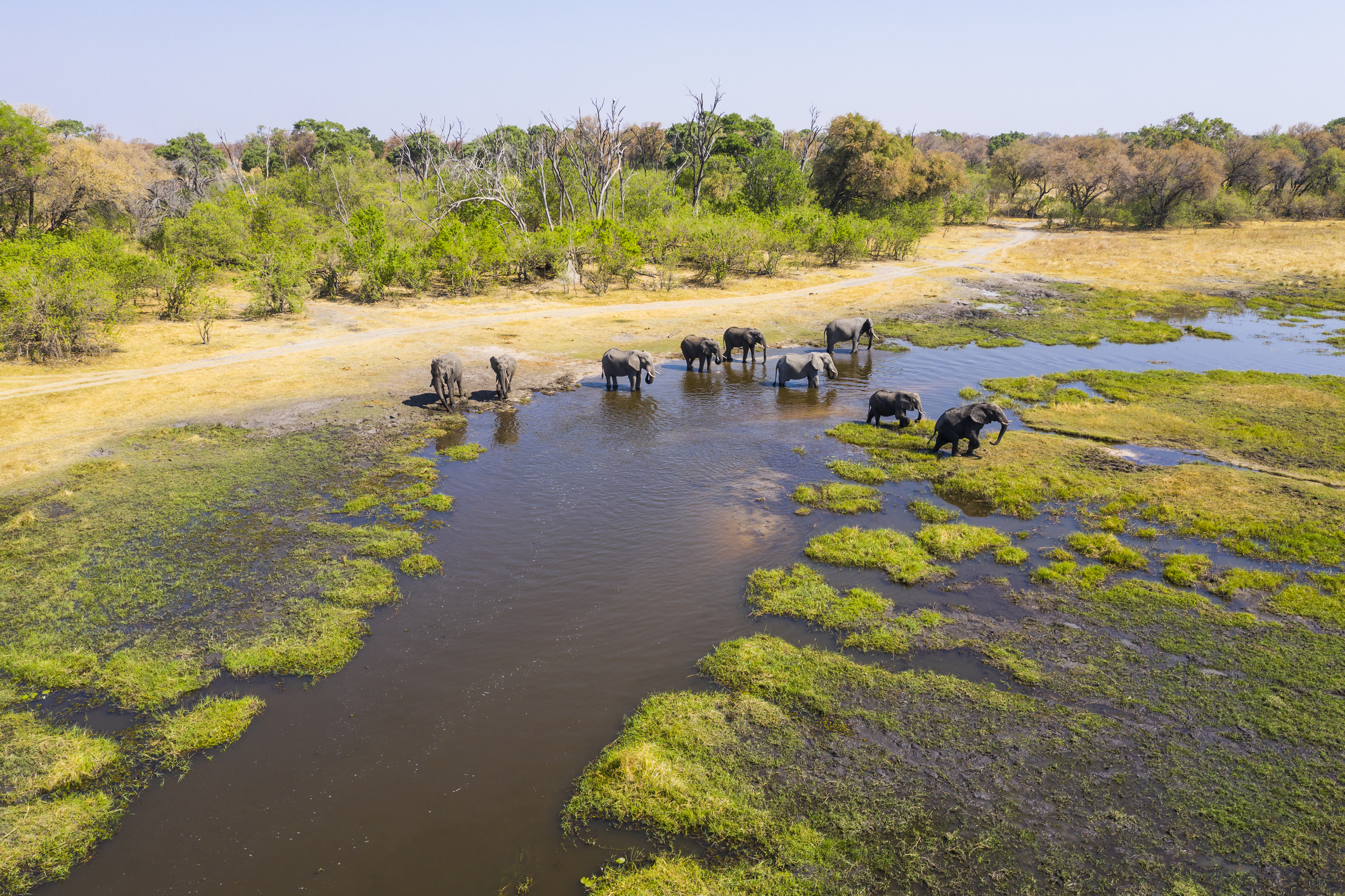Satellites find likely cause of mysterious African elephant deaths of 2020
Climate extremes seem to have exacerbated toxins in the elephants' water supply.

The staggering and unexplained deaths of over 300 African elephants in early 2020 — one of the largest mass mortality events of wild mammals in recent history — was most likely due to toxins in water that proliferated due to climate extremes, according to a fresh analysis of a decade's worth of satellite data.
The mass death, a "conservation disaster" that occurred over the course of three months in Botswana's Okavango Delta, saw some elephant carcasses clustered around waterholes and others collapsed face-first on the ground. While the region is a known poaching hotspot, the tusks of the elephants were found intact, ruling out human interference and prompting scientists to look for other causes.
Yet, efforts to establish a definitive cause of the mass mortality event — which would have involved collecting water and tissue samples to directly test for the presence of cyanotoxins — were hindered by the remote location of the Okavango Delta and further complicated by logistical challenges due to the COVID-19 pandemic. The tragedy occurred during the peak of the pandemic, which restricted movement and delayed critical fieldwork, preventing researchers from gathering direct evidence.
Now, however, a study combining satellite observations and aerial surveys of over 3,000 waterholes in the region found elevated algal levels near the deceased elephants, strengthening previous evidence that cyanobacterial neurotoxins — toxic compounds produced by microscopic blue-green algae called cyanobacteria — are the likely culprit behind the mass deaths.
"Algal blooms are routinely monitored by satellite, but this data isn't often used to investigate mass mortality events," study lead author Davide Lomeo of King's College London said in a statement. "As the scale of elephant deaths from unknown causes was much higher than anything that's been seen before, it's important to use all sources of evidence to investigate what happened to these endangered animals."
Cyanotoxin concentrations in African inland water sources are often found to be thousands of times higher than World Health Organization guidelines regarding safe drinking water for animals and humans. Still, satellite images of the Okavango Delta between 2015 and 2023 revealed cyanobacteria blooms had exploded to unprecedented levels during an unusually rainy season in early 2020, following the driest season in decades during the year prior.
This extreme shift from drought to intense rainfall delivered dramatic volumes of water to waterholes that were either completely dry or had very little water remaining after the 2019 drought, according to a new study published in the journal Science of The Total Environment. This sudden influx of water caused the resuspension of high amounts of nutrients and sediments from at least 20 waterbeds of varying sizes, triggering frequent and severe growth of cyanobacteria known to thrive in nutrient-rich waters.
Get the Space.com Newsletter
Breaking space news, the latest updates on rocket launches, skywatching events and more!
Satellite imagery also showed that the algae proliferated the most between March and May 2020, at the end of the rainy season. As temperatures rose, the water became stagnant, further enhancing the conditions for the cyanobacteria to thrive and produce unprecedented levels of toxins.

When the elephants drank from these contaminated waterholes, they would have ingested lethal doses of cyanotoxins, which may have led to organ failure and ultimately caused their deaths.
The suffering animals likely traveled about 10.25 miles (16.5 kilometers) and died within 88 hours after being exposed to the toxins, the study found, which aligns with reported timelines of deaths associated with cyanobacterial poisoning in other large mammals. Elephants may have also moved closer to water sources in their final days, potentially seeking hydration from increasingly toxic waterholes as they grew weaker. The close proximity of the carcasses to these waterholes supports the hypothesis that the elephants' deaths were linked to the toxicity of the water, researchers say.
"They have no choice but to drink from them," Lomeo told The Guardian. "Botswana is home to a third of all African elephants, and this unprecedented die-off within their largest remaining population underlines the escalating concerns surrounding the impact of drought and climate change on the Okavango Delta, one of the most important ecosystems in the world," he added in a statement.
It is possible that elephants' drinking behavior made them particularly susceptible to intoxication. Elephants can drink between 100 and 200 liters of water every day and likely drank from multiple waterholes before their deaths, the new study suggests. Unlike other animals that drink from the side of waterholes, elephants also tend to wade to the middle and submerge their trunks, possibly exposing them to higher concentrations of cyanotoxins than other animals utilizing the same resource. Still, smaller animals may have also succumbed after consuming the contaminated water, but it's likely that their carcasses were either scavenged by other animals or had already decomposed by the time of the aerial survey.
While toxin-producing strains of cyanobacteria have been observed on the African continent, the toxins themselves are not detectable from space, making it challenging to determine which waterholes were contaminated and for how long.
Niall McCann of the U.K.'s National Park Rescue, who was not associated with the new study, told The Guardian that these findings add "to the growing body of evidence that climate change can have a range of lethal effects on wildlife (as well as livestock and people), from radically changing water availability, to providing the conditions for harmful bacteria and algae to proliferate and overwhelm animal populations".
The findings raise broader concerns about the impact of climate change on Africa's wildlife, particularly as southern Africa is projected to become hotter and drier in the coming decades. As temperatures rise and precipitation patterns shift unpredictably, these findings underscore the need for comprehensive water quality surveillance across all water sources, including the smallest ones, the researchers say. Globally, the mass deaths underscore an alarming trend of rapid, climate-induced diseases, said Lomeo.
There is "no reason to think an event like this won't happen again."
Join our Space Forums to keep talking space on the latest missions, night sky and more! And if you have a news tip, correction or comment, let us know at: community@space.com.

Sharmila Kuthunur is a Seattle-based science journalist focusing on astronomy and space exploration. Her work has also appeared in Scientific American, Astronomy and Live Science, among other publications. She has earned a master's degree in journalism from Northeastern University in Boston. Follow her on BlueSky @skuthunur.bsky.social









